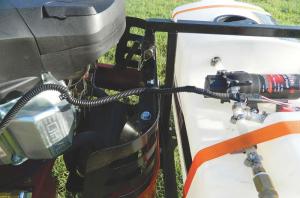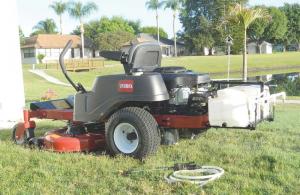2015 - Volume #39, Issue #3, Page #33
[ Sample Stories From This Issue | List of All Stories In This Issue | Print this story
| Read this issue]
Spray Boom Mounted On Zero-Turn Riding Mower
 |
 |
The sprayer is complete with an 8-gal. tank, 32-in. pvc boom, and hand nozzle with 15 ft. of hose. It’s operated by a 12-volt pump that hooks up to the mower battery.
He used scrap angle iron and 1-in. box tubing salvaged from an old bed frame to build a subframe that bolts on back of the mower and supports the sprayer’s tank, boom, and pump. He added a short vertical length of 1-in. box tubing on top of the subframe and also drilled a pair of holes into the mower hitch to accept two 1/4-in. bolts as pilot pins.
To attach the sprayer, Bennett drops the sprayer into the subframe and then inserts a 3/8-in. lynch pin to secure it. The 1/4-in. pilot bolts help align the sprayer frame to the mower hitch. He then hooks up the pump by way of a 2-wire plug at the sprayer area, and inserts a foot-operated switch plug.
“It really works great and is easy to operate,” says Bennett. “The boom is made from 1/2-in. schedule 40 pvc pipe and is equipped with 4 spray nozzles. It rides only about 12 in. off the ground, which minimizes drift.
“The boom can be raised or lowered several inches to facilitate adequate coverage. An inline selector valve allows spray to be directed to the boom, to the hand wand, or both. I installed a brass quick-disconnect fitting for the hand wand hose in case it’s not needed.”
Bennett says fire ants are a real problem in his area, and hiring a service to control them can get expensive. “It costs about $80 per month to have someone come out every 3 months to spray our approximately 10,000 sq. ft. lawn, but I can control them for only $4 to $5 per application. I use Talsar or Bifenthrin 7.9 percent concentrate at about one gal. of spray mix per 1,000 sq. ft. of lawn. The insecticide is also available in a 25.1 percent concentrate which is even more convenient to use.
“The sprayer does a good job of controlling all bugs including termites and many other insects for 3 months or so between treatments. I use the hand wand to spray under bushes and shrubs.”
Bennett uses the foot-operated switch to turn the sprayer pump on or off, which allows him to keep both hands on the mower’s control arms at all times. “I assembled the foot control box by installing a headlight dimmer switch as the on-off switch with an indicator light inside an aluminum electrical box. I attached magnets to the bottom of the box to make a temporary mount on the mower’s steel toe plate.
“The switch box has a 2-in. flexible cable which attaches by way of a trailer light plug and receptacle. This allows the switch box to be removed whenever the sprayer is not in use. Whenever the mower is running the engine noise is too loud for me to hear if the sprayer pump is running, so that’s why I installed an indicator light on the switch box,” he says. “I may install a pressure gauge on or around the toe board so I can monitor the spray operation and know when the tank solution is running empty.”
He bought the 8-gal. sprayer online from Northern Tool for about $60. “My total cost was less than $200,” notes Bennett.
“With the sprayer and a full tank of spray solution, you’re adding about 50 lbs. of weight on back of the mower. Anyone considering this idea should read their mower operating manual for information on safe operation on hills or slopes, as the added weight may affect safe operation.”
Contact: FARM SHOW Followup, Stan Bennett, 3153 Bluebird Ave., Lake Placid, Fla. 33852 (ph 269 429-3872; stnbenn2001@yahoo.com).

Click here to download page story appeared in.

Click here to read entire issue
To read the rest of this story, download this issue below or click here to register with your account number.




